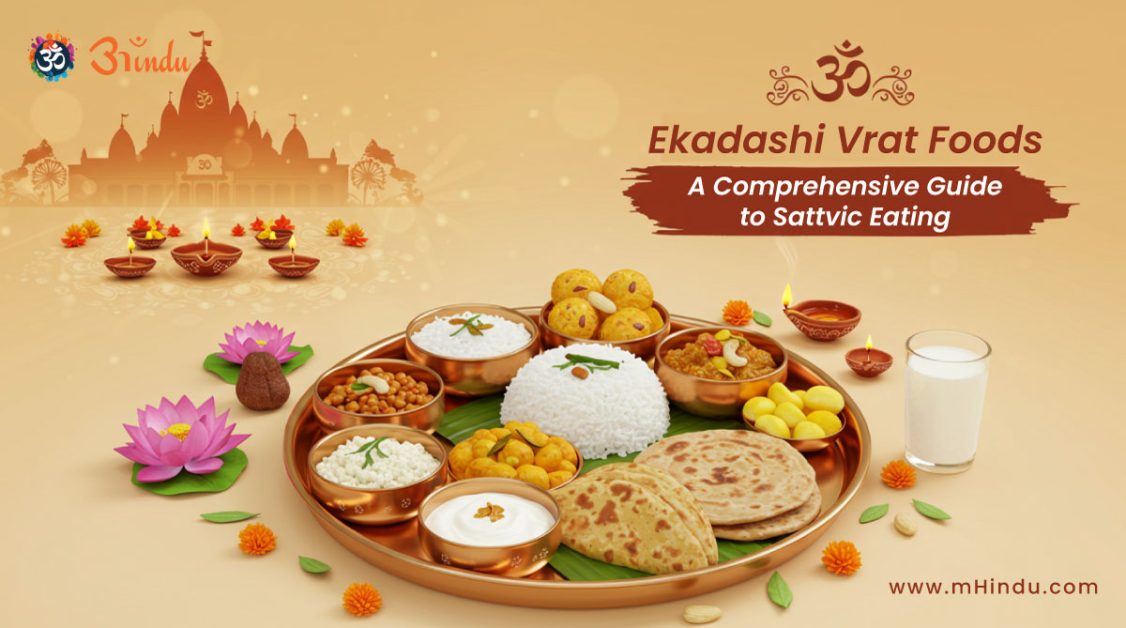
Ekadashi, a revered day in the Hindu calendar, is observed with fasting and deep spiritual devotion. Understanding the essence of Ekadashi vrat foods is paramount for those undertaking this sacred fast. It involves consuming specific sattvic (pure) food items, not merely for physical abstinence, but for profound spiritual purification. This guide delves into the intricate details of permissible foods, preparation guidelines, and the spiritual significance of adhering to a sattvic diet during Ekadashi.
Explore Blog Content
ToggleThe Sacred Observance of Ekadashi and Its Dietary Significance
Ekadashi, occurring on the eleventh day of the waxing and waning phases of the moon, holds immense spiritual significance for Hindus. This day is dedicated to fasting, prayer, and introspection, aimed at purifying the body and mind. The dietary restrictions during Ekadashi are not arbitrary; they are meticulously designed to foster a state of sattva, or purity, which is conducive to spiritual practice. The selection of food for Ekadashi is carefully curated to support this spiritual journey, avoiding tamasic (heavy) and rajasic (stimulating) foods. To understand the broader context of fasting in Hinduism, explore this article: 10 Benefits of Fasting in Hinduism. Additionally, to delve into the spiritual significance of fasting, read this: The Spiritual Significance of Fasting in Hinduism. To understand the rituals that are performed, this article is useful: How to perform daily puja a step by step guide.
Understanding the Essence of Sattvic Foods in Ekadashi Vrata
The concept of sattvic foods is fundamental to Ekadashi fasting. These foods are pure, light, and promote mental clarity and spiritual well-being. Unlike tamasic and rajasic foods, which can induce lethargy or agitation, sattvic foods help maintain a balanced state conducive to meditation and prayer. This concept ties into the broader practices of yoga and Hinduism, which emphasize purity and balance: Yoga and Hinduism.
- Purity and Cleanliness:
- The emphasis on “clean” ingredients signifies using items specifically designated for Ekadashi, preventing cross-contamination with everyday cooking.
- This includes using “clean salt,” “clean sugar,” and “clean oil,” stored in separate containers to maintain their purity.
- Permissible Oils and Fats:
- Avoid soya oil and corn oil, which are considered less pure and may hinder spiritual focus.
- Opt for pure, unsalted ghee, butter, or specific plant-based oils like peanut, coconut, sunflower, or Helios oil, which are considered sattvic.
A Comprehensive List of Permitted Ekadashi Recipes
The following is a detailed list of food items that can be consumed during Ekadashi, categorized for clarity:
- Fruits and Vegetables:
- All kinds of fruits are generally permitted, including lemons, green bananas, and coconut, which provide essential nutrients and energy.
- Vegetables like cabbage, butternut, gem squash, karela (bitter melon), lettuce, and cucumber are also allowed, offering a variety of vitamins and minerals.
- Pumpkin seeds are also allowed, providing healthy fats.
- Dairy Products (with Specific Guidelines):
- Cheese such as Tussers, mozzarella, Parmesan, and feta are permissible, provided they are made without animal rennet, ensuring they are vegetarian.
- Cottage cheese (paneer), yogurt (maas), fresh cream, sour cream, and condensed milk are also allowed, offering protein and calcium.
- Nuts and Seeds:
- Almonds (badam), cashews, pistachios, peanuts, poppy seeds, and raisins are allowed, providing healthy fats, protein, and energy.
- Spices and Herbs:
- Thyme, saffron, basil, bay leaves, parsley, cinnamon sticks, paprika, curry leaves, nigella seeds, mint (pudina), cardamom (elachi), coriander (dhania/cilantro), cloves, ginger, nutmeg (jaifar), chillies (green or dried red), ground/whole pepper, turmeric (ground from raw form), tamarind, and hing (in its raw form) are allowed, adding flavor and medicinal benefits.
- Other Permitted Items:
- Jaggery (gur), lemon juice, rosewater, desiccated coconut, sago (saigo), and vanilla (pod) are allowed, offering natural sweetness and flavor.
- Rooibos tea, and Green tea are also permitted, for hydration.
Foods to Avoid During Ekadashi Vrata
It is equally important to understand which foods to avoid during Ekadashi to maintain the sanctity of the fast:
- Grains: Rice, wheat, and all other grains are strictly prohibited.
- Legumes: Beans, lentils, and peas are avoided as they are considered heavy and difficult to digest.
- Root Vegetables: Potatoes, onions, and garlic are avoided as they are believed to induce tamasic qualities.
- Non-Sattvic Oils: Soya oil and corn oil are avoided due to their processing and potential impact on spiritual focus.
- Non-Vegetarian Food: All non-vegetarian food is strictly prohibited.
The Significance of “Clean” Ingredients in Ekadashi Food Preparation
The concept of “clean” ingredients extends beyond mere hygiene; it signifies spiritual purity and mindfulness.
- Separate Storage and Preparation:
- Keeping Ekadashi ingredients in separate containers and using dedicated utensils prevents contamination from everyday cooking, which may involve non-sattvic foods.
- This practice reinforces the spiritual intent behind the fast, ensuring that the food consumed is pure and conducive to devotion.
- Spiritual Intent and Mindfulness:
- Preparing food with a mindful and devotional attitude, chanting mantras or prayers during the process, enhances the spiritual significance of the meal.
Ekadashi Vrat Foods and Their Impact on Spiritual Practice
The choice of food for Ekadashi directly influences the quality of spiritual practice during Ekadashi.
- Mental Clarity and Focus:
- Sattvic foods promote mental clarity and focus, which are essential for meditation, prayer, and introspection.
- Physical Lightness and Energy:
- Light, easily digestible foods prevent lethargy and maintain physical energy, allowing for sustained focus on spiritual activities.
- Emotional Balance and Harmony:
- These foods help maintain emotional balance and harmony, preventing mood swings that can disrupt spiritual practice.
Ekadashi Food Preparation: Practical Tips and Guidelines
- Simplicity and Purity:
- Keep meals simple and light, avoiding elaborate preparations that may distract from spiritual focus.
- Use fresh, high-quality ingredients to maximize their sattvic qualities.
- Mindful Cooking and Offering:
- Prepare food with a mindful and devotional attitude, chanting mantras or prayers during the process.
- Offering the prepared food to the deity before consumption.
Conclusion: Embracing Sattvic Eating for Spiritual Purification and Growth
Observing Ekadashi with the right Ekadashi recipes is a powerful practice for purifying the body and mind, enhancing spiritual growth. By adhering to sattvic dietary guidelines, devotees can experience a deeper connection with the divine, fostering inner peace, clarity, and harmony. This practice is not merely about abstaining from certain foods; it’s about embracing a lifestyle that supports spiritual evolution. Understanding Karma, the law of cause and effect, can further deepen the understanding of the reasons behind such practices: Understanding Karma the law of cause and effect 2. Also, the 7 principles of hinduism can provide context: explanation of hinduism 7 principles for a more meaningful life.
FAQs
- What foods are allowed during Ekadashi Vrata?
Fruits, certain vegetables, dairy products without animal rennet, nuts, specific spices, and oils like ghee and coconut oil are allowed, providing essential nutrients and energy. - Why is it important to use “clean” ingredients on Ekadashi?
Using “clean” ingredients, stored separately, ensures purity and prevents contamination from non-sattvic foods, maintaining the spiritual integrity of the fast and enhancing devotion. - Can I eat dairy products on Ekadashi?
Yes, but only dairy products made without animal rennet, such as paneer, yogurt, and specific cheeses, which are considered sattvic. - Are all spices allowed during Ekadashi?
Specific sattvic spices like cardamom, cinnamon, ginger, and turmeric are allowed, while others may be avoided due to their potential to stimulate rajasic qualities. - What oils are permitted for cooking Ekadashi foods?
Ghee, butter, and plant-based oils like peanut, coconut, sunflower, and Helios oil are permitted, while soya and corn oil should be avoided. - Why are grains and legumes avoided during Ekadashi?
Grains and legumes are considered heavy and difficult to digest, which can hinder spiritual practice by causing lethargy and disrupting mental clarity. - How does food impact spiritual practice during Ekadashi?
Sattvic foods promote mental clarity and physical lightness, enhancing meditation and prayer, while non-sattvic foods can disrupt these practices by inducing lethargy or agitation. - Can I eat fruits and vegetables on Ekadashi?
Yes, most fruits and many vegetables are permitted, providing essential nutrients and maintaining the sattvic diet, supporting spiritual well-being.







